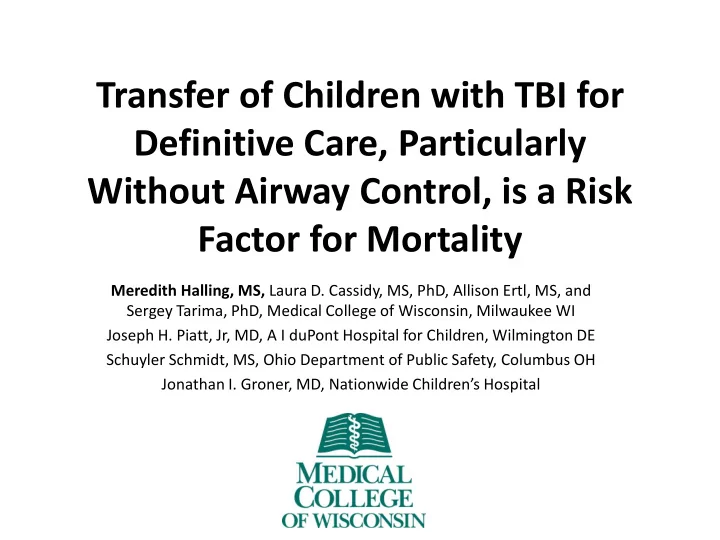

Transfer of Children with TBI for Definitive Care, Particularly Without Airway Control, is a Risk Factor for Mortality Meredith Halling, MS, Laura D. Cassidy, MS, PhD, Allison Ertl, MS, and Sergey Tarima, PhD, Medical College of Wisconsin, Milwaukee WI Joseph H. Piatt, Jr, MD, A I duPont Hospital for Children, Wilmington DE Schuyler Schmidt, MS, Ohio Department of Public Safety, Columbus OH Jonathan I. Groner, MD, Nationwide Children’s Hospital
Funding acknowledgement This research was supported by the National Institute of Child Health and Human Development of the National Institutes of Health under award number 1RO3HD071924-01A1, July 1, 2013 – June 30, 2015
Pediatric Head Injury • Head injury – leading cause of death and disability in children and adolescents in the United States and worldwide – can have long-lasting and significant implications for cognitive and motor function abilities Pediatric TBI patients have demonstrated better outcomes when treated at pediatric trauma centers (PTC). Outcomes for pediatric head injury patients treated at non-trauma centers (NTC) are not well documented.
Primary aim: Identify variables predictive of survival to hospital discharge among two populations of pediatric head injury patients: Cohort 1: Patients admitted directly to a level 1 pediatric trauma center (PTC) Cohort 2: Patients transferred to a PTC from a trauma center (TC) or a non-trauma center (NTC). - Is intubation in the PTC Emergency Department (ED) for patients admitted directly to a PTC and those transferred into a PTC associated with decreased survival?
Study Population • Ohio Trauma Registry: Captures data from 89% of Ohio hospitals, including 138 NTC • Data from the years 2007-2012, head injury defined by ICD9 codes 800 – 801.99, 850.0 – 854, 803-804.99, 995.55
Analysis • Patient characteristics and differences between the two patient populations were assessed using chi-squared test. • Logistic regression analyses were used to model the probability of in-hospital death based on potential covariates including: – age – sex – race – payment source – Injury Severity Score – whether the patient underwent a neurosurgical procedure – mechanism of injury – Glasgow Coma Scale (GCS) – whether or not the patient was intubated in ED upon arriving at PTC • Two separate regression models created – one for each cohort
Population characteristics Direct admit to Transferred in to Level 1 Level 1 Pediatric TC Pediatric TC Characteristic n = 980 n = 2154 p-value Neurosurgical <.0001 procedure No 869 (88.7) 2020 (93.8) Yes 111 (11.3) 134 (6.2) Glasgow Coma Scale <.0001 3 – 8 108 (11.0) 32 (1.5) 9 – 12 55 (5.6) 35 (1.6) 13 – 15 573 (58.5) 1525 (70.8) Not documented 244 (24.9) 562 (26.1) Injury severity score <.0001 1 – 8 349 (35.6) 1119 (52.0) 9 – 14 227 (23.2) 541 (25.1) 16 – 25 274 (28.0) 372 (17.3) >25 130 (13.3) 122 (5.7) Injury Type <.0001 Blunt 961 (98.1) 2146 (99.6) Penetrating 20 (1.9) 8 (0.4) Head max AIS <.0001 No 114 (11.6) 90 (4.1) Yes 866 (88.4) 2064 (95.8) ED Intubation 0.0001 Intubated at ED 96 (9.8) 157 (7.2) No airway placed 569 (58.1) 1417 (65.8) Not doc/NA 315 (32.1) 580 (26.9)
Population characteristics: Race Cohort 2: Transferred in to PTC Cohort 1: Direct to PTC White: 55% White: 82% Black: 8% Black: 33% Other: 6% Other: 7% Not documented:5% Not documented: 5%
Population characteristics: Payment source Cohort 2: Transferred in to PTC Cohort 1: Direct to PTC Private: 27% Private: 38% Public: 36% Public: 32% Self-pay: 8% Self-pay: 7% Not documented: 30% Not documented:23%
Population characteristics: Injury Mechanism Cohort 2: Transferred in to PTC Cohort 1: Direct to PTC MVC: 30% MVC: 41% Fall: 46% Fall: 28% Other: 1% Other: 1% Unkown: 23% Unkown: 30%
Adjusted Risk of Mortality Age groups Direct to PTC Age Odds ratio (95% CI) for in-hospital death p-value <1 2.91 (0.90 – 9.44) 0.0751 * ** 1 - 4 3.59 (1.31 – 9.85) 0.0132 5 - 9 1.36 (0.45 – 4.12) 0.5871 10 - 13 0.68 (0.21 – 2.17) 0.5098 14 - 15 Referent Transfer Age Odds ratio (95% CI) for in-hospital death p-value <1 11.52 (2.36 – 53.30) 0.0025 ** 1 - 4 3.67 (0.79 – 16.95) 0.0963 * 5 - 9 2.56 (0.49 – 13.38) 0.2639 10 - 13 0.76 (0.13 – 4.62) 0.7670 14 - 15 Referent
Adjusted Risk of Mortality Payment source Direct to PTC Payment source Odds ratio (95% CI) for in-hospital death p-value Private Referent * Public 2.49 (0.98 – 6.31) 0.0551 ** Self-pay 6.19 (2.31 – 16.62) 0.0003 Not documented 4.47 (1.41 – 14.14) 0.0108 Transfer - Payment source was not a significant factor and ended up being removed during backwards selection.
Adjusted Risk of Mortality PTC ED Intubation Direct to PTC Intubated in ED Odds ratio (95% CI) for in-hospital death p-value No airway placed Referent Intubated at ED 10.36 (4.10 – 26.20) <.0001 ** Not doc/NA 1.09 (0.35 – 3.43) 0.8846 No airway placed Referent Transfer Intubated in ED Odds ratio (95% CI) for in-hospital death p-value No airway placed Referent Intubated at ED 93.57 (25.81 – 339.20) <.0001 ** Not doc/NA 3.07 (0.69 – 13.73) 0.1412 No airway placed Referent
Conclusions • Patients admitted directly to a PTC had a high percentage of patients who were non-white, on public insurance, and severely injured, with motor vehicle accident as the most common mechanism • There are some factors that predict risk of in-hospital mortality in both cohorts; however, the two cohorts have distinct risk profiles • After controlling for injury severity, patients admitted directly to a PTC who required intubation in the ED were 10 times more likely to die. Transferred patients who required intubation upon arrival at the PTC ED were 94 times more likely to die • Transfer with appropriate airway control is a potential focus for quality improvement
Thank you
Recommend
More recommend